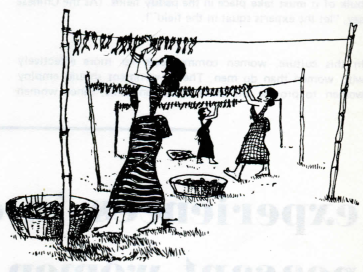Women and agricultural development
For any urbanite who ever has stepped out of the city,something we would urge that the experts, the intelligentsia, and the decision makers do,
it becomes clear that women historically have played, and continue to play a major role in agricultural development .
Being cognizant of the attention span of readers the major feminine activities are itemized below. However, before we itemize them, two major points should be stressed :
1 . Until recently, women generally have been neglected by those who analyze how development could and should take place.
2 . We detest compartmentalization, which is a bureaucratic and intellectual convenience. It is misleading to isolate the " agriculture sector " from " the role of women " .
The " woman " issue paradoxically is both clear and complex. How can women gain access to resources ( not just in agriculture)? Why have they not gained access to the resources? What can the women themselves do to alter this apparent injustice? What role do women play in the rural (urban) decision - making process? What can others do including the Government?
Two points must be stressed before we confine ourselves to " women in agriculture " .
First, focussing on women as a factor of production is an economic, and not social, cause. Cliches were made to be used ; women do represent" vast untapped resources ".
Second, recently women have become the bull's eye of the " target group" concept. It is not for someone on high to decide what women should receive .


Within the above context the major current activities of women in agriculture are :
1 . Choosing seed grain
2 . Sprouting seeds
3 . Tending seedlings
4 . Storing seed grains
5 . Seed multiplication
6 . Threshing, winnowing, husking paddy.
7 . Parboiling and drying paddy .
8 . Storing food grain
9 . Processing rice for sale (muri, chira)
1 0 . Cultivating and preserving vegetables and fruit
1 1 . Pesiculture
1 2 . Fish - drying
1 3 . Caring for small livestock, poultry, ducks
1 4 . Gathering fuel and storing a water supply
1 5 . Stripping jute fibre
Thus, one would be naive to ask: What work could women do in the agricultural sector?
The point is that women already are playing a significant role! The questions are:
1. Why are they not doing what they are now doing better (could they be more productive?);
2. What could they do more; why are they not doing it?
To our knowledge these are unanswered questions, certainly of incentives, and, almost certainly, of technology. These questions cannot be answered in the context of the "agriculture box", but in the context of the total national battle for resources.
However, certain concrete and productive steps could be taken. The first is to take the discussion out of the drawing rooms of Dacca, Chittagong, Khulna and other urban areas into the field.
In the field, first we should make a comprehensive inventory of what women are doing now in the rural sector and how, if at all, they are rewarded for their efforts. In clinical terms we should focus on how to increase productivity, examine the relationships between increased productivity and incentives, and seek to understand the nature of the incentives.
However, as many of both sexes have learned, painfully, the making of studies in many cases is a convenient delaying technique. We do not want our suggestions to be misconstrued in that light. Some work must be done in the libraries, but the bulk of it must take place in the paddy fields. (As the Chinese say, "let the experts squat in the field").
In this culture, women communicate far more effectively with women than do men. The Government should employ women to provide the communication links. Since women play such a major role in agriculture some extension efforts must be addressed to them.
Not only for women, but in general, the top down governmental approach has its limitations. Women, a major component that the main stream of development has by-passed, should recognize this. Unquestionably the Government has a responsibility. But in most countries, the Government may need to be reminded of its responsibilities.
To recapitulate:
1. Women continue to play a major role in agriculture.
2. This role generally has not been recognized by many of the men and women who recently have "become aware" of women.
3. The new focus on women, in general, and in particular in agriculture, primarily should be economic and not welfare.
4. To our knowledge very little is known of these matters; how women's productivity could be increased; how, and if the scope of their activities could increase; what the relationship is between productivity and incentives; and the nature of the incentives.
5. Rural women should be aware that they are not alone having been by-passed generally by the main stream of development. Accordingly, they are not alone in their struggle to gain access to scarce resources. (This may seem to be a cliche, but it is not!
6. Women can communicate more effectively with women than can men. Accordingly, it appears reasonable that women should be involved in the communication process, since they are involved heavily in agricultural production.
A. Z. M. Obaidullah Khan
(From Adab News, 549F, Road 14, Dhanmondi, Dacca 5, Bangladesh, June 1977).

